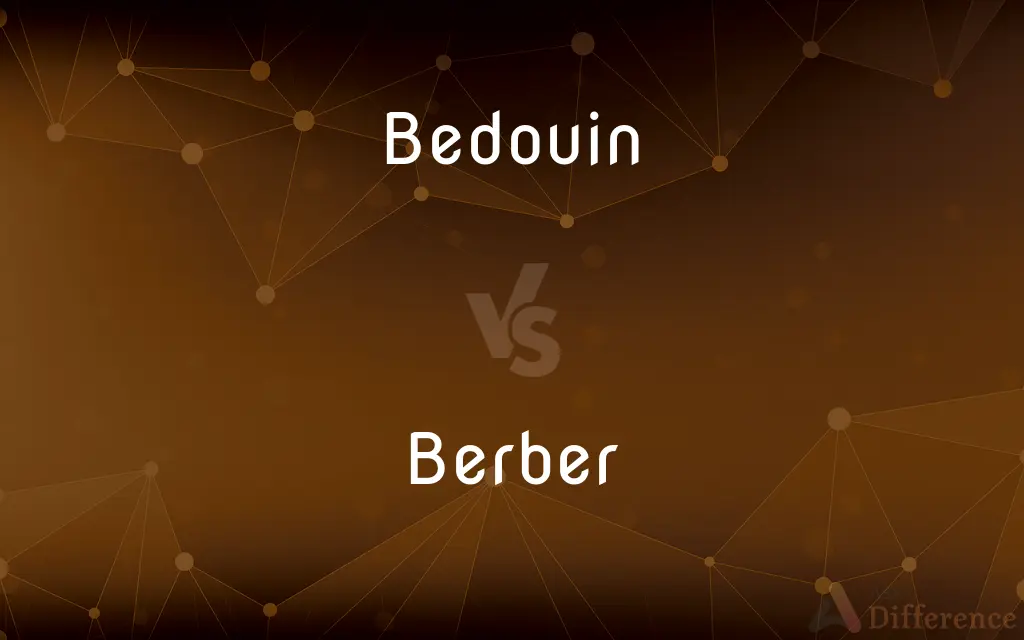Bedouin vs. Berber — What's the Difference?
Edited by Tayyaba Rehman — By Fiza Rafique — Updated on March 22, 2024
Bedouin traditionally refers to nomadic Arab peoples of the desert regions in the Middle East, while Berber pertains to indigenous groups in North Africa, not primarily nomadic.

Difference Between Bedouin and Berber
Table of Contents
ADVERTISEMENT
Key Differences
The Bedouin are traditionally nomadic Arab people who have historically inhabited the desert regions in the Middle East, such as the Arabian Peninsula, the Syrian Desert, and the Sinai Peninsula. Whereas, the Berbers are indigenous peoples of North Africa, residing mainly in areas ranging from the Atlantic Ocean to the Siwa Oasis in Egypt, and from the Mediterranean Sea to the Niger River.
Bedouin society is characterized by tribal and familial loyalty, often organized in tribes or clans with a deep sense of solidarity and social cohesion. Their culture is rich in traditions, poetry, music, and oral history, which are central to preserving their identity. On the other hand, Berber society is known for its rich history, diverse languages (collectively known as Tamazight), and varied cultural practices, including both sedentary agricultural communities and some nomadic or semi-nomadic tribes.
The Bedouins have traditionally lived in tents and are famed for their hospitality, a vital aspect of their culture, offering protection and hospitality to travelers. In contrast, Berbers have a history that includes living in various dwellings, from traditional tents in nomadic communities to mud-brick houses in villages and ksars (fortified villages) in mountainous areas. The Berber architecture, especially in regions like Morocco's Atlas Mountains and Algeria's Kabylie, is noted for its harmony with the environment.
While the Bedouin culture and language (varieties of Arabic) are generally uniform across different regions, reflecting their spread across the Middle East, the Berbers are ethnically diverse and speak several Berber languages and dialects. This linguistic diversity is a testament to the Berbers' long history and their interactions with other cultures and invaders, including the Romans, Arabs, and French.
Despite the differences, both the Bedouins and Berbers have faced challenges in the modern era, including issues related to land rights, modernization, and the preservation of their traditional way of life. However, both groups continue to play a significant role in the cultural and social landscapes of their respective regions.
ADVERTISEMENT
Comparison Chart
Location
Desert regions in the Middle East
North Africa
Lifestyle
Traditionally nomadic
Varied, including sedentary and nomadic
Society
Tribal and familial loyalty
Ethnically diverse, rich in history
Dwellings
Tents
Tents, mud-brick houses, ksars
Language
Arabic
Berber languages (Tamazight)
Cultural Practices
Hospitality, poetry, music
Diverse, including agriculture, architecture
Challenges
Modernization, land rights
Modernization, cultural preservation
Compare with Definitions
Bedouin
Cultural Traditions.
Bedouin culture includes rich oral traditions and poetry.
Berber
Berber Languages.
Berbers speak several languages, all part of the Tamazight family.
Bedouin
Desert Dwellings.
Traditional Bedouin tents are designed for desert conditions.
Berber
Indigenous People.
Berbers are indigenous to North Africa with a diverse culture.
Bedouin
Arabic Language.
The Bedouin speak various dialects of Arabic.
Berber
Varied Lifestyle.
Berber lifestyles range from sedentary farming to nomadism.
Bedouin
Nomadic Lifestyle.
The Bedouin people's nomadic lifestyle is adapted to desert living.
Berber
Diverse Dwellings.
Berbers live in a variety of homes, including ksars in mountains.
Bedouin
Tribal Society.
Bedouin tribes place a high value on solidarity and hospitality.
Berber
Architectural Harmony.
Berber architecture is notable for its environmental harmony.
Bedouin
The Bedouin, Beduin or Bedu (; Arabic: بَدْو, romanized: badū, singular بَدَوِي badawī) are nomadic Arab tribes who have historically inhabited the desert regions in the Arabian Peninsula, North Africa, the Levant, and Mesopotamia. However, the Arabian Peninsula is the historic and original homeland of the Bedouin Arabs.
Berber
A member of a race somewhat resembling the Arabs, but often classed as Hamitic, who were formerly the inhabitants of the whole of North Africa from the Mediterranean southward into the Sahara, and who still occupy a large part of that region; - called also Kabyles. Also, the language spoken by this people.
Bedouin
An Arab of any of the nomadic tribes of the Arabian, Syrian, Nubian, or Sahara Deserts.
Berber
A member of a North African, primarily Muslim people living in settled or nomadic tribes from Morocco to Egypt.
Bedouin
A member of nomadic Arab tribes dwelling in the desert.
Berber
Any of the Afro-Asiatic languages of the Berbers.
Bedouin
One of the nomadic Arabs who live in tents, and are scattered over Arabia, Syria, and northern Africa, esp. in the deserts.
Berber
A member of a Caucasoid Muslim people of northern Africa
Bedouin
Pertaining to the Bedouins; nomad.
Berber
An ethnic minority descended from Berbers and Arabs and living in northern Africa
Bedouin
A member of a nomadic tribe of Arabs
Berber
A cluster of related dialects that were once the major language of northern Africa west of Egypt; now spoken mostly in Morocco
Common Curiosities
Who are the Bedouin?
The Bedouin are nomadic Arab peoples traditionally living in the desert regions of the Middle East.
How do Berber societies differ from Bedouin societies?
Berber societies are ethnically diverse, with a mix of sedentary and nomadic lifestyles, unlike the traditionally nomadic Bedouin.
What languages do the Bedouin speak?
The Bedouin speak various dialects of Arabic.
What type of dwellings do Berbers live in?
Berbers live in a variety of dwellings, from tents to mud-brick houses and fortified villages.
Can Bedouin and Berbers be found outside their traditional regions?
Yes, both groups have diaspora communities around the world, particularly in urban areas and other countries.
Who are the Berbers?
Berbers are indigenous peoples of North Africa, known for their diverse culture and languages.
How do the Bedouin and Berbers contribute to their countries' cultures?
They enrich their countries' cultural landscapes with their unique traditions, languages, and lifestyles.
What is the traditional lifestyle of the Bedouin?
The Bedouin traditionally lead a nomadic lifestyle, centered around herding and moving through desert areas.
What are some cultural practices of the Bedouin?
Bedouin cultural practices include a strong tradition of hospitality, poetry, and oral history.
What are the challenges faced by the Berbers today?
Berbers work towards maintaining their cultural identity and traditions amid modernization pressures.
What languages do the Berbers speak?
Berbers speak several Berber languages and dialects, collectively known as Tamazight.
How have the Bedouin adapted to modern challenges?
The Bedouin face challenges related to land rights and modernization, striving to preserve their traditional way of life.
What architectural styles are associated with the Berbers?
Berber architecture includes the distinctive ksars and mud-brick homes, known for blending with the natural environment.
What is the significance of hospitality in Bedouin culture?
Hospitality is a fundamental value in Bedouin culture, symbolizing respect and solidarity among people.
How do language and ethnicity play a role in Berber identity?
Language and ethnicity are central to Berber identity, reflecting their history, diversity, and resilience.
Share Your Discovery

Previous Comparison
Process vs. Wise
Next Comparison
Naturalism vs. RomanticismAuthor Spotlight
Written by
Fiza RafiqueFiza Rafique is a skilled content writer at AskDifference.com, where she meticulously refines and enhances written pieces. Drawing from her vast editorial expertise, Fiza ensures clarity, accuracy, and precision in every article. Passionate about language, she continually seeks to elevate the quality of content for readers worldwide.
Edited by
Tayyaba RehmanTayyaba Rehman is a distinguished writer, currently serving as a primary contributor to askdifference.com. As a researcher in semantics and etymology, Tayyaba's passion for the complexity of languages and their distinctions has found a perfect home on the platform. Tayyaba delves into the intricacies of language, distinguishing between commonly confused words and phrases, thereby providing clarity for readers worldwide.
















































